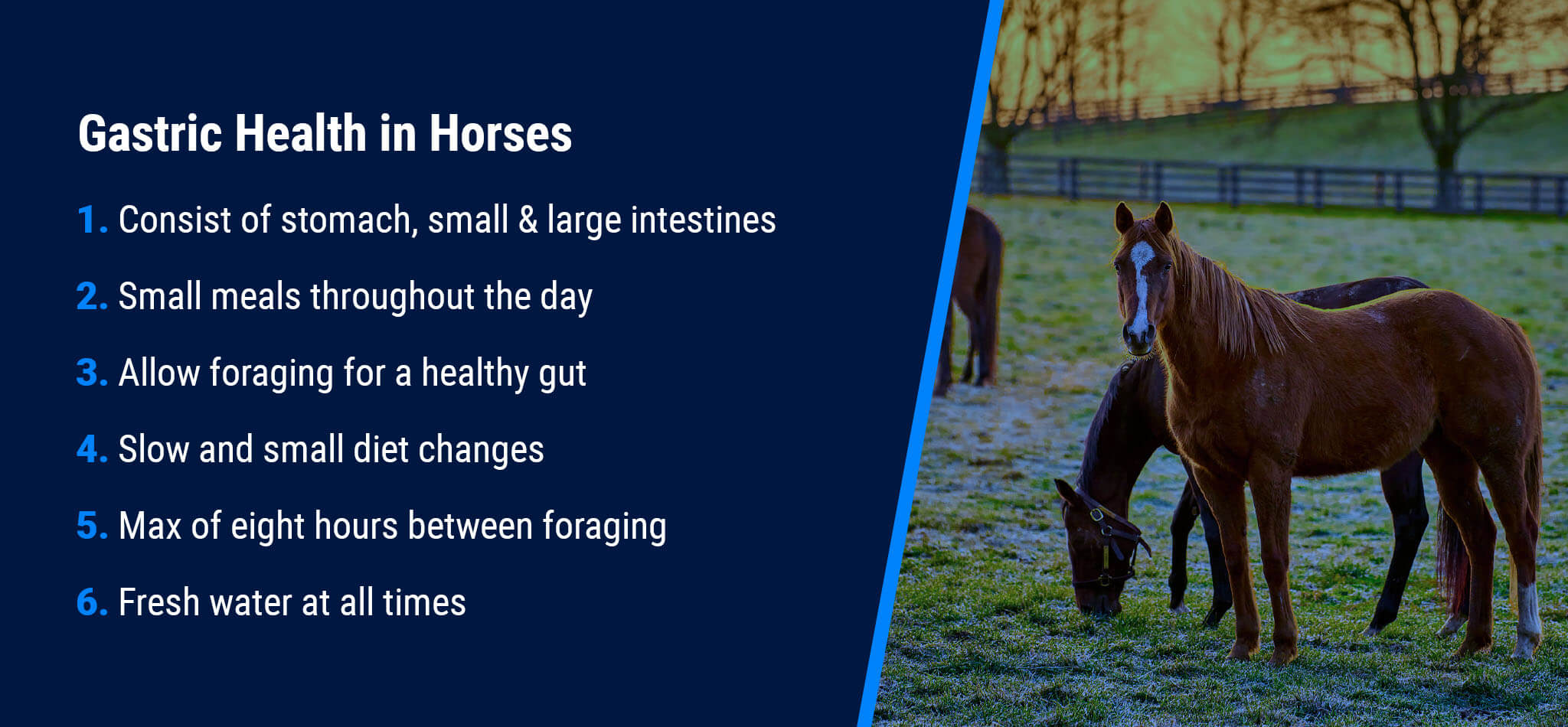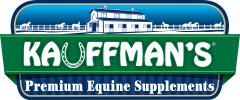How to Maintain Gastric Health in Your Horse
A horse’s gastric system is an important part of its overall health and happiness. Many owners are surprised to learn how complicated the equine digestive system is. Understanding your horse’s digestive system aids in maintaining gastric health.
Table of Contents
- The Stomach
- The Small Intestine
- The Large Intestine
- Best Practices for Gastric Maintenance
- Focusing on Digestive Health Management

1. The Stomach
When a horse eats, its mouth and esophagus break apart the food so it can travel to the stomach. Compared to other animals, a horse’s stomach is small. In fact, the stomach makes up just 10% of the equine gastric system and holds only two to four gallons of material at once. This is because horses evolved to forage, or eat small amounts of food over the course of the whole day.
Unlike the human stomach, a horse’s stomach does not stretch to accommodate larger meals. In ideal conditions, horses consume small portions that give their stomach time to digest the feed properly. The foraging instinct provides an efficient solution to satisfy a horse’s appetite while respecting the animal’s small stomach capacity.
The stomach is the place where the equine digestive process begins. Hydrochloric acid and two enzymes begin to dissolve food, pepsin helps digest proteins and gastric lipase breaks down fat. When the stomach is two-thirds full, it passes its contents to the small intestine.
2. The Small Intestine
The small intestine of a horse is around 60 to 70 feet long and can hold about 12 gallons at once. Feed takes between two to four hours to pass through the small intestine, where a significant portion of digestion takes place. Enzymes break down the feed. Fat, vitamins, minerals and protein are absorbed and transported into the blood supply.
Your horse’s pancreas and liver help digest protein, carbs and fat. Horses in the wild survive on low-fat, high-forage diets. Even so, they can handle diets that contain as much as 15% fat due to their liver’s constant secretion of bile. After food moves through the small intestine, it makes its way to the large intestine.
3. The Large Intestine
A horse’s large intestine begins with the cecum, a comma-shaped sac that breaks fiber down using fermentation. The large colon continues the job of fermentation and helps absorb the resulting nutrients. Movement through the large intestine is much slower than the small intestine. It can take 36 to 48 hours for feed to reach the end. During this time, the large intestine performs two crucial tasks that support a horse’s gastric and overall health: microbial digestion and water absorption.
Microbial digestion in the large intestine produces vitamins K, E and B as well as volatile fatty acids your horse needs for energy production. A healthy gut microbe population supports this essential gastric function. It’s important to remember that a horse’s microbial population changes very slowly in reaction to a new diet. If you alter your horse’s diet slowly, you can give the large intestine several days of acclimation to adjust and promote ideal microbial digestion.
The other main function of this digestive tract element is to absorb and recycle water. Water is crucial for healthy digestion, as it helps move the food through the length of the tract. For ideal gastric health and digestion, a horse needs to consume five to 10 gallons of water every day. If the animal is particularly active or working in a hot climate, that figure could double.
Best Practices for Gastric Maintenance
There are several considerations and practices that can help your horse in maintaining digestive health.
First, it’s important to be mindful of how long a horse’s stomach is empty. The stomach is divided into two halves. The upper half of the stomach is less resistant to the continually secreted stomach acid. To support a healthy stomach that functions at its full capacity, break your horse’s daily food allotment into two or three small meals per day. In general, horses should never have forage withheld for longer than eight hours.
The second main consideration is the horse’s diet. A horse’s nutritional needs can be met with about 1% of its body weight in forage and the rest in concentrate. Even so, high-forage diet equal to 2% or 2 1/2% of total body weight is ideal in maintaining gastric health. The type of feed a horse receives can have a significant impact on its digestive health. Any grain added to a horse’s diet to balance nutrition should be clean and of good quality to promote safe and efficient digestion.
In summary, you can do your part in maintaining your horse’s gastric health and digestive system by:
- Feeding two to three small meals per day
- Keeping the stomach adequately filled with forage to reduce acidity
- Feeding only four to five pounds of cereal-based feed at once
- Ensuring the diet does not contain more than 15% fat
- Allowing adequate foraging to maintain gut microbes
- Changing diet slowly over time
- Allowing access to forage with withholding periods of eight hours maximum
- Offering clean, fresh water at all times
Focusing on Digestive Health Management
Supporting a healthy equine digestive system is easiest when you consider the animal’s natural state. Mirroring the conditions horses experience in the wild, such as ample access to grass and shortened periods between feedings, helps to promote digestive balance.
